

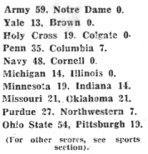
VOL. III NO. 11 REG NO. L5015 DELHI, THURSDAY NOVEMBER 23, 1944
NEW DELHI - American Army Engineers are building an oil pipeline from India through Burma into China to alleviate the acute fuel shortage in that hard-pressed country.
Starting at Calcutta, the pipeline already makes its way through Bengal and Assam, and over the Patkai
 T/Sgts. Richard N. Bosted and Bert A. Stapleton, two members of a pipeline unit, carry a section of pipe through
a monsoon-drenched jungle area.
T/Sgts. Richard N. Bosted and Bert A. Stapleton, two members of a pipeline unit, carry a section of pipe through
a monsoon-drenched jungle area.
|
This potential source of fuel supply for the Air Forces and Ground Forces in China is already being used to advantage by troops on the India side of The Hump.
On its way up to Assam, it services the India bases of the B-29 Super-Fortresses.
Other airfields in Assam, the fighter bases, and fields from which transports take off for The Hump flight are getting fuel from the line, taking a tremendous load off the already overburdened railway lines which run out of Calcutta into Assam, especially the G.I.-operated meter gauge Bengal and Assam Railway which is the principal supply line for troops in Assam.
Trucks in Assam and North Burma are operating on fuel brought up to the forward areas through the
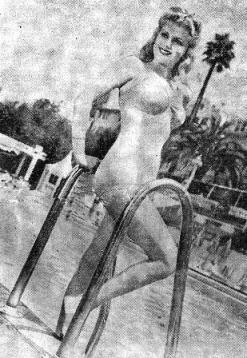 You've probably a feeling of nostalgia for a California swimming pool, so that's the reason for this page one picture.
Don't you wish Dolores Moran would get out of the way and quit blotting out the background? Oh, you wouldn't. Oh.
You've probably a feeling of nostalgia for a California swimming pool, so that's the reason for this page one picture.
Don't you wish Dolores Moran would get out of the way and quit blotting out the background? Oh, you wouldn't. Oh.
|
Built of 4" and 6" "invasion" pipe, the type which became famous in the invasion of North Africa, when pipelines were strung behind advancing troops as they went inland to carry up fuel for their tanks and trucks, the new line through India and Burma has been laid quickly. Lighter than ordinary pipe, "invasion" pipe is easier to handle, saves cargo space and tonnage in ships which bring it over from the United States to Indian ports. One section of the 4" pipe can be loaded inside a section of 6" pipe when it is being shipped, resulting in an almost 50 percent saving in shipping space. Fuels now going through the pipeline are aviation gas, motor fuel and diesel oil.
The men of the Engineer Petroleum Distribution Companies who have laid the pipeline have worked in conditions never before encountered in the laying of such a line. Monsoon rains have turned whole areas through which the pipe has been laid into boiling streams. Pipe has been laid under streams and rivers, and over them, through wet jungles, over mountains and through gorges. At times, men laying the pipe have been shot at by Japanese snipers, but still the work has gone ahead rapidly.
The line is being built by the SOS Construction Service, which is headed by Brig. Gen. Thomas F. Farell, former Chief Engineer of the State of New York at Albany. Direct responsibility for the two main sections of the line has fallen to two ex-U.S. pipeline experts. The first of these, Col. William C. Kinsolving, of Beaumont, Tex., has had charge of the building of the section from Calcutta into Assam. Kinsolving had a part in the planning of the "Big Inch line which has helped relieve the U.S. east coast oil shortage. The second of these men, Lt. Col. Birney K. Morse of Swarthmore, Pa., is in charge of the forward section of the line which is making its way through Northern Burma.
Completion of this line to China will not only alleviate the oil shortage on that side of The Hump, but will release valuable ATC cargo space which is now used for transporting fuel to China in drums, for use in shipment of other supplies of war.

|
CARMEL, CALIF. - Wearing a green uniform, devoid of any ribbons or decorations, Gen. Joseph W. Stilwell spent two informal hours chatting mostly about his garden, his family and the weather in his first press conference since returning to the United States.
Uncle Joe, home for a rest, talked about almost anything but the military situation in China or the conditions which led to his removal as commander of the CBI Theater.
Asked whether he would say anything about China, Stilwell affably replied he "would rather leave political and civilian views of China completely out of the discussion."
The general spoke glowingly of "the kids of America," as he compared them with the youth of other countries. "I'll take my hat off to them. They understand team play thoroughly. They are keenly intellectual and they are full of initiative. The Japs put soldier caps on their kids when they are just knee high. I think our way is a damn sight better, with better results."
His statement drew a question concerning his stand on compulsory military training, but he refused a direct comment. He replied to a remark that "apparently we are able to dig up an army whenever we need one" with the statement: "Yes, but at considerable expense and grief. We can always stand a little more preparation, but the stuff we have is good."
When photographers chided the general about his dislike for wearing a hat, he closed the interview by explaining, "Someone stole my overcoat and raincoat along the line. Can you imagine those souvenir hunters? I had a helluva time hanging onto my shoes."
CHIANG ANNOUNCES CABINET SHAKEUP
CHUNGKING - (ANS) - Generalissimo Chiang Kai-shek removed six of his top-ranking cabinet members Monday in a governmental shakeup which correspondents were permitted to say was undertaken to meet the objection of the People's Political Council, headed by Chiang.
The major victim of the shakeup was Gen. Ho Ying Chin, who was ousted as Minister of War, but retained his seat as Chief of Staff of the Army. His ministry seat went to Gen. Chen Cheng, former commander of the First War Zone and long a confidential adviser of Chiang.
Finance Minister H. H. Kung, brother-in-law of Madame Chiang, was replaced by O. K. Yui, former assistant in that Ministry.
HURLEY THE MAN? FOR CHINA POST
WASHINGTON - (ANS) - President Roosevelt told a news conference this week that he already has picked an ambassador to replace Clarence E. Gauss in China, but is awaiting acceptance from China before sending the nomination to the Senate.
Both United Press and Associated Press cited speculation in the Capital on the possibility of the post going to Maj. Gen. Patrick Hurley, who went to Chungking in August with former WPB Chairman Donald M. Nelson as the President's personal representative.
Chinese diplomats here said that Hurley gets along well with Generalissimo Chiang Kai-shek and is popular in Chungking.
Nelson recently returned to China.
New SEAC Air Boss Reported Missing
LONDON - Air Chief Marshal Sir Trafford Leigh Mallory, newly appointed to the SEAC staff of Lord Louis Mountbatten, as Air Commander in Chief, and Lady Leigh Mallory have been missing since Nov. 14, when the plane in which they were traveling to Ceylon failed to reach its destination.
Leigh Mallory commanded aerial operations during the invasion of Western Europe.
WHEELER SUCCESSOR TO STILWELL AT SEAC
CEYLON - Lt. Gen. Raymond A. Wheeler was announced as successor to Gen. Joseph W. Stilwell as Deputy Commander of the Allied South East Asia Command, and will continue as the command's Principal Administrative Officer.
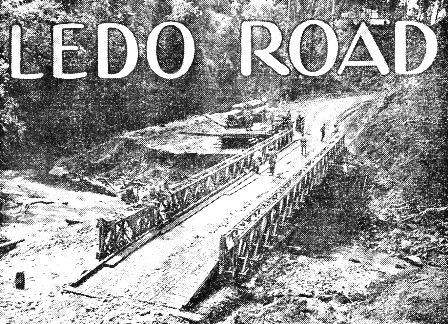 A newly-constructed Bailey Bridge - latest in military stream crossing equipment - replaces a temporary wooden
structure over a stream on the Ledo Road in Burma.
A newly-constructed Bailey Bridge - latest in military stream crossing equipment - replaces a temporary wooden
structure over a stream on the Ledo Road in Burma.
|
ALONG THE LEDO ROAD - The Ledo Road is as American as a hot dog with mustard or a stolen kiss at the Junior Prom.
I have just completed a trip up the Road, from its terminus at the tiny, dingy bazaar of Ledo, Assam,

|
The Road is a single, minute thread of modern America almost lost in the vast green tapestry of a dim, primordial world which, for countless centuries, has afforded the elephant and tiger and devil-tormented aborigine a refuge from the encroaching tides of civilization.
But, despite the dank, dense vegetation of the jungle, the steep, uncharted mountains and low, steaming swamplands - despite month-long monsoon downpours, mud and disease - the American soldier has transplanted the spirit of his homeland in this remote corner of the world.
When I made my first trip up the Ledo Road months ago, it was little more than a rough combat trace. Its course through the precipitous Patkai Mountains of Burma was highlighted by hundreds of breath-taking hairpin curves and narrow, wooden bridges over turbulent mountain streams.
But today great changes are evident. The Ledo Road, day by day, is becoming a modern American highway. New fills and cuts are being made, shortening the road and eliminating the bad curves. Rock crushers operate day and night as maintenance crews surface the Road with layer after layer of crushed rock taken from mountain streambeds by dredges and draglines.
Sheer walls of earth which tower ominously above the road in many places, constituting an ever-present threat of landslide-created road blocks, are being dynamited back from the roadway and thousands of tons of mountainside are being hauled away by long queues of dump trucks and squat carry-alls.
Temporary wooden bridges have been replaced practically 100 percent by steel structures. Recently, installation of Bailey Bridges - the latest design in military stream-crossing equipment - has been instituted.
In the Upper Hukawng and Mogaung Valleys I discovered that during the past monsoon - the heaviest in recent years - Services of Supply troops had accomplished the impossible in the movement of heavy equipment into the forward areas of the Road.
Here they assembled vast backlogs of bulldozers, road graders, carry-alls, steam shovels, steam rollers, mobile machine shops, generators, pontoon equipment, steel bridge sections, rock crushers, culvert and all the other myriad pieces of equipment which would be needed to push the Ledo Road on south into Burma and across to China with the advent of the dry season.
The fact that all this gargantuan engineering equipment had been brought over slender, and sometimes primitive, supply lines 14,000 miles from Engineer Depots in the United States was amazing. But even more unbelievable was the fact that American soldiers, working night and day during the torrential rains and battling mud and jungle disease, had assembled this vital equipment at the point of the Road, where it would be ready for instant use when the rains ended. The job these unknown and unsung heroes accomplished has easily knocked several months off the time required for the final link-up of the Ledo and Burma Roads.
Today, American Engineers, working side by side with Chinese engineers, are pushing the Ledo Road through a swampy section of North Burma. It is a tough job. Topographical profiles have to be worked out painstakingly, for drainage is the big problem in this area. The roadbed is being built high, and culverts installed at regular intervals to carry off excessive floodwater during the monsoon season.
 A G.I. operates a huge crane in swinging a span of steel bridge across a jungle stream.
A G.I. operates a huge crane in swinging a span of steel bridge across a jungle stream.
|
Up ahead of the bulldozers and road graders are the demolition crews - veteran Negro Engineers who handle the "hot stuff" with incredible non-chalance. These men are blasting a path through the jungle for the heavy equipment, following a course determined by survey parties which work still farther ahead.
And, skirting the trace, Chinese engineers have constructed a corduroy road, built of timbers which have been hewn by hand. This wooden road makes it possible for trucks to carry supplies and equipment into the jungle to the men who are working far ahead of the passable portion of the new roadbed.
Up forward on the trace, I found a crew of Chinese and American Engineers laying two sections of 36-inch culvert. I stopped and talked with Maj. E. M. Johnson, of Pueblo, Colo., who is working out of Road Headquarters. When I asked him how the Chinese were doing, he replied:
"They're hot. They've got lots of the old American urge to break production records. Yesterday this same gang installed a section of 72-inch culvert in 10 hours - a job which normally requires at least two days."
Nearby, a stocky Chinese wrestled a heavy section of culvert into place, wiped the perspiration from his face and grinned the inevitable, "Ding-how, Joe."
M/Sgt. A. O. Anderson, of Chicago, and T/5 John J. Tanchyn, of Scranton, Pa., who were supervising the laying of the culvert, said that the Chinese were excellent workers whenever Americans took the time to explain the details of a job.
Predominant as the spirit of America is in the engineering feats being accomplished in the jungles of Burma, it is even more apparent in the men who are working on the Road.
I stopped for dinner at an evacuation hospital tucked away among a grove of hollong trees at the foot of the purple Patkai Mountains. After dining on Spanish omelets a la powdered eggs, I lingered long enough to watch a few innings of a ball game being played on a diamond which the hospital personnel had cleared and leveled from virgin jungle territory. A rabid crowd of fans, including numerous Chinese patients, hurled insults at the umpire in the best approved Flatbush fashion.
Everywhere along the Road, the G.I.'s had provided for athletic activity. Basketball and volleyball courts were the most numerous. At one place, a lusty gang of American soldiers was indulging in a fast game of volleyball on a court built between two tents on a wind-swept knoll overlooking a deep gorge. At a camp which some weary Engineer, with the typical G.I.'s grim sense of humor, had dubbed "Camp Neverest," two men were playing horseshoes beside the Road while several kibitzers sprawled on the ground nearby.
At Shingbwiyang, on the edge of the Hukawng Valley, I went to the Metz Theater - named after a soldier who was killed by a Jap land mine when the fighting was raging near this Northern Burma outpost last January.
Five American girls were putting on a USO show for the troops. The natural amphitheater in which the movie is located was crowded to overflowing. And, when the girls staged a jitterbug contest on the stage with contestants selected from the audience, the crowd picked a small, nimble chap with a conspicuous bald pate, as the winner. His award was a kiss - not one of those casual pecks on the cheek, but a long, lusty bit of osculation. The crowd roared its approval.
Pfc. Henry M. Jakob, working as a cook at officers' mess in Shingbwiyang, typifies the versatility of the American soldier. He arrived in Ledo with a Quartermaster outfit 22 months ago and was put into a newly-formed air-dropping unit. He completed 250 combat flying hours in the early days when air-dropping was a grim business, and for that service he was awarded the Air Medal.
Leaving air-dropping, he served as an MP, then volunteered for a special experiment which resulted in the Soldiers Medal. Later, he served as a truck driver on the Ledo Road.
 The old and new. Elephants carrying G.I.'s on a timber cruise pause beside a bulldozer that is carving a new
roadbed for the Ledo Road in the jungles of Burma.
The old and new. Elephants carrying G.I.'s on a timber cruise pause beside a bulldozer that is carving a new
roadbed for the Ledo Road in the jungles of Burma.
|
Life for the G.I. pushing the point through the jungles of Burma is a transient affair. The men set up camp, work for a few days in one area, then break camp - usually at night after finishing work - and move forward again. This goes on, week after week, during the dry season when the Road moves forward approximately two miles a day.
But still the men manage to maintain a vestige of the niceties of the civilization they have left behind. One outfit has made has made portable wooden bunks with rubber springs fashioned from worn-out inner tubes. Another has a portable washing machine. In one camp, near the point of the Road, I saw a sign reading "Joe's Tonsorial Palace." Inside the tent, I found a barber's chair made from a heterogeneous collection of odds and ends. The outfit had carried the chair from one camp to another for over a year.
Another unit has a portable kitchen, mounted on a 6x6 truck, enabling the men to have warm meals even when the outfit is on the move. And one enterprising G.I. has set up a dice table in his quarters, supplemented by an antiquated slot machine which can be played with one-quarter rupee coins. At present, the dice table is gathering cobwebs, for "the house" was taken for 4,800 rupees one night in a big game which has become legendary up and down the Ledo Road.
And thirsty G.I.'s with parched palates have devised sundry ingenious stills which turn out such potent juices as "raisin jack" and "cherry squeezins."
As one G.I. remarked, as we watched a coolie leaning on a shovel beside the Road humming his Indian version of Pistol Packin' Mama which some American soldier had taught him:
"People back home worry about us G.I.'s in the jungle going native. Hell, it's just the opposite. The natives are going American!"
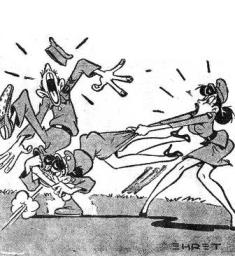 "NO! NO! EUNICE! DON'T GET SO UPSET JUST BECAUSE A G.I. FORGETS TO SALUTE."
"NO! NO! EUNICE! DON'T GET SO UPSET JUST BECAUSE A G.I. FORGETS TO SALUTE."
|
38TH DIVISION TROOPS PROBE INTO BHAMO
NORTHERN BURMA - The encirclement of Bhamo, last remaining major Jap hurdle barring extension of the land route from India eastward to the Burma Road, was completed this week when determined Chinese forces moved east from Shwego and west from Momauk to clamp tight holds on the two roads leading south from the enemy stronghold.
Surrounded, the Japs launched a small-scale, but vicious, counter-attack from the southeast sector of Bhamo, spearheaded by a force of four tanks. The Chinese of the 38th Division returned 400 yards of captured territory, but their response was vigorous and they knocked out two of the tanks.
Two days later, 38th troops thrust into the southwest part of the town, following in the wake of American dive-bombers. They occupied one block of houses, inflicting casualties, and captured equipment, including ammunition and a 75mm artillery piece.
next day, the Japs counter-attacked viciously, with hand-to-hand fighting resulting. Bayonets and hand grenades were used. Full results are not yet known.
Meanwhile, the British 36th Division, bulling its way down the Railroad Corridor, captured the Pinwe Railroad Station, but are still a mile north of the town. Opposition is stiff. There are numerous Jap bunkers and defenses offered by wooden positions holding up the advance.
After stiff fighting, Chinese units of the 38th Division moving from the east now control 13 miles of the spur road from Bhamo south to the Burma Road. Thirty-eighth Division troops cleared the last pocket of resistance in the Momauk area in clearing the road from Bhamo to Myothit and, according to Lt. Gen. Dan I. Sultan, killed over 100 Japs in the last two days of fighting. Sultan revealed the enemy has suffered 1,900 dead in the campaign since Oct. 15.
Japs To Pour Big Army Into China?
CHUNGKING - Japan is pouring a formidable, well-trained and equipped army into China and is planning to fight out the war on the Asiatic mainland, Maj. Gen. Albert C. Wedemeyer, commander of the U.S. forces in the China Theater, said this week.
He predicted that the Japs will be defeated about a year after the close of the war in Europe.
In the meantime, the Chinese High Command admitted that Liuchow, important air base of the 14th Air Force, had been abandoned and that Jap columns had also captured Chikiang, 55 miles below Liuchow on the highway to Nanning. The fall of Nanning would leave the Japs only 110 miles to go before establishing the overland link between Manchuria and Indo-China.
Ishan, 43 miles northwest of fallen Liuchow, has also fallen to the Japanese, the Chinese High Command said. This new success along the Kwangsi-Kweichow Railroad came as Donald M. Nelson and 13 American industrial experts and advisers to China's new War Production Board arrived in an attempt to increase China's production.
P-47's Prowl As EAC Enjoys Week Of Action
EAC HEADQUARTERS - Activity the past week saw P-47's out in force every day. They destroyed a railroad bridge four miles south of Kawlin, knocked out another at Meza, bombed the Hsenwi and Namhkai bridges, bombed and strafed Jap troop concentrations and stores at Hsipaw, Bawgyo, Pinwe, Indaw, Pegon and Wetlet; caused a violent explosion in the military area at Wuntho, and strafed airfields at Nawnghkio and Kawlin, destroying enemy aircraft on the ground.
Tenth Air Force B-25's made several successful attacks on Lashio, bombed the Kawlin Airfield, causing explosions and fires, and made a rail sweep during which they fired a locomotive at Kanbalu and damaged a number of
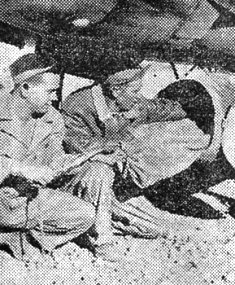 In China, members of the "Assam Squadron" of the 14th Air Force's "Flying Horse" group exercise traditional ingenuity
in getting their mail. They merely stow a bag of mail in the belly tank of a P-40 Shark. S/Sgt. John R.
Armstrong and Sgt. Roland Cheavacci display how it's done.
In China, members of the "Assam Squadron" of the 14th Air Force's "Flying Horse" group exercise traditional ingenuity
in getting their mail. They merely stow a bag of mail in the belly tank of a P-40 Shark. S/Sgt. John R.
Armstrong and Sgt. Roland Cheavacci display how it's done.
|
ON CHINDWIN FRONT
On the Tiddim-Chindwin fronts, fighter-bombers and dive bombers of the Third Tactical Air Force were also out every day with great success. Hurricanes and Hurribombers were particularly active against the Kalewa waterfront. They destroyed a span on bridge at Hpanugzeik, and in another sweep knocked out five bridges across the Shwegyin River. But their main targets were the Jap positions and emplacements on the front lines.
RAF Thunderbolts of the Third Tactical Air Force concentrated on Jap airfields in the Mandalay area. On one sweep, they destroyed one aircraft and damaged another on the ground at Thedaw. Tenth Air Force B-25's, operating under the Third Tactical Air Force, bombed the Shwebo freight yards, tracks and rolling stock at Kin-U. They scored direct hits on the Mu River and Saye bridges; bombed the Ywataung railroad yards with excellent results; hit the shore sidings at Sagaing; attacked the railroad yards at Paleik, damaging a large portion of the track area and hit Myitnge.
RANGOON RUMBLE
USAAF P-38's of the Third Tactical Air Force hit airfields in the Rangoon area for a round trip of more than 350 miles. The Lightning's claimed one probable and one damaged out of a flight of 12 enemy aircraft. They also swept airfields in the Mandalay area. Fighters of the First Air Commando Group also hit the same airfields during the week.
Seventh Bomb Group B-24's destroyed three rail bridges at Hninpale on the railroad between Rangoon and Moulmein. Two days later, the hit the stores and jetties at Mergui. Fires were visible for 140 miles. The next day, the B-24's attacked key points on the Bangkok-Chiengmai Railroad, inflicting severe damage to locomotive sheds and the stations at Pitsanuloke, Pakanpoh and Uttaradit.
Beaufighters continued their attacks on rolling stock and shipping in Central and Southern Burma. Two schooners were hit off Kalegauk Island and a double-decked steamer hit near Bassein.
14TH AIR FORCE HITS JAPS HEAVY BLOWS
Japanese successes this week in Kwangsi Province were gained only at heavy cost, as 14th Air Force fighters, catching the enemy in close formation, killed hundreds of troops, cavalry and pack horses in strafing attacks over the Liuchow-Ishan-Tatang battle area.
Fighters also damaged a railroad bridge near Liuchow, sank a steamer on the Lung River near Sancha and damaged Japanese tanks. Other fighters, together with B-25's, hit enemy rear areas. Tanchuk airfield was bombed twice, and Siangtan, Lingling and Paoching fields also hit.
16 NIPS DROWNED
Over 15 Nip interceptors were met near Hengyang, with four destroyed, two probably destroyed and nine damaged. Seven Japs were destroyed at Kinkiang field and five more in the Yellow River area.
Northern-based fighters ranged clear to Suchow, 150 miles west of the Yellow Sea, to destroy 21 locomotives on the Lung hai railroad.
During bad weather on the Kwangsi front, air operations were heavy in the Salween area. Much-bombed Wanling burned most of the week, while other attacks were pressed against Cefang, Mangshih and the Man Pwe rail yards.
FREIGHTERS SUNK
Two Japanese freighters of 250-foot length and a large Jap tanker were sunk in the South China sea by night-searching B-24's, as was one other small cargo vessel. A large freighter was probably sunk and one cargo vessel damaged in further attacks. Fort Bayard on the Liuchow peninsula and the Kowloon docks at Hong Kong were each bombed twice by B-24's.
B-25's and fighters over French Indo-China and Thailand bombed 13 bridges on the coastal railway, destroyed four locomotives and made a surprise attack on a Jap-operated carbide mine at Queen Yen.
G.I. PSYCHOLOGY
APO 492 (Bombay) - Pvt. Dave Durrow, PX clerk here, was worried at the non-sale of "Duke's Mixture" tobacco, long gathering dust on his shelves. So he slapped a sign on the stock, "Limit - one package per man, no exceptions." It's all gone now.
SALWEEN CHINESE OCCUPY MANGSHIH
SALWEEN FRONT - American trained and equipped troops of the Chinese Salween Expeditionary Force this week captured Mangshih, last remaining Japanese fortress along the Burma Road towards Bhamo, according to the Associated Press. Mangshih fell after heavy bombing attacks by the 14th AF on enemy installations.
With the fall of Lungling, and now Mangshih, the last two ...
ASC PLANT IN MYSORE STATE KEEPS 'EM FLYING
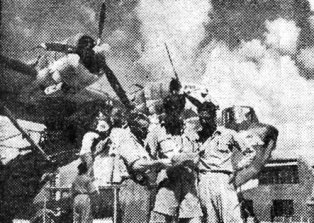
|

|
The camera offers the fundamental interpretation of "Allied" in the left picture. Left to right, American Lynn B. Keeler, civilian employer; Sgt. James Petrie, RAF aircraft inspector; and B. M. Malkini, Indian supervisor of marine overhaul. The belly tanks, right, have enough capacity to send a B-25 on a globe-circling mission.
ASC DEPOT, SOUTHERN INDIA - A bit of wartime America with its humming aircraft plants and hordes of denim-garbed workers lies superimposed on the fertile plains here. Except that the workers are sons of India and other Far Easterners, it duplicates the U.S. scene.
The "big fellows" of the skyways roll in, sometimes "limping" for surgical treatment or arriving for periodic maintenance overhaul. They're greeted quickly by scores of hands which now knowingly move with efficiency and rapidity.
Long before the United States Army Air Forces moved into India to build bases for thrusts at Jap installations in Burma and Southeast Asia, the Hindustan Aircraft, Ltd., only plane factory in this region of the globe, was making the inhabitants of Mysore State (in which the plant is located) air-minded. The plant was conceived in 1939 and constructed in 1940 along modern lines, modern enough to cope with the demands placed on it today by the Air Service Command as it accomplishes its mission of "keeping 'em flying" against the Japs. In January, 1942, it began the maintenance and repair of American fighter and bomber craft and RAF and Dutch flying boats. The following year, it was placed in entirety under USAAF control, with the Air Service Command as the operating agency. The plant is owned jointly by the Goverments of Mysore State and India.
The big job which the Air Service Command then tackled was to acquaint the workers, 90 percent of whom are Mysore residents, with maintenance and repair methods as established by the USAAF. It required extensive schooling, but progress was rapid. Upward of 13,000 men are employed in the plant in addition to the ASC troops, skilled specialists in aircraft doctoring, and of this number 25 percent had to be skilled labor to obtain the necessary efficiency.
John M. Hamilton, of Riverside, Conn., a Notre Dame graduate, was handed the job of factory manager. He had been in the Far East prior to the war, scratching his head over knotty problems at the Central Aircraft Plant in western China. Hamilton discovered that the mechanically-inclined Indian was both an industrious and capable worker. Each man was taught a specific operation to be accomplished during the overhaul. On this basis, much in the fashion of Henry Ford's mass production idea of cars, the massive engines are torn down and put through a complete check-up before re-assembly.
The American factory scene also come to life when the five o'clock whistle shrills in the air. The sheds and hangars empty quickly, for a new shift takes over. They leave the plant in thin queues which thicken as they near the gate and the roads leading to the gate, over which fly the flags of Uncle Sam, John Bull and Mysore, are swelled with figures on the homeward trek. They go and come by foot, bicycle, buses and a special train for those who live beyond other means of transportation.
Hamilton has figured that the earning powers of the plant's employees radiate to more than 100,000 people, spreading a more wholesome life and happiness in Mysore State.
Out "on the line" the Air Service Command men are responsible for the vital decisions. Besides the knowledge and experience they lend to the Bangalore operation, they serve as air inspectors. Theirs is the last word as to whether the shop is in top fighting trim for AAF flyers - and if it isn't, they set to work to make it pass with flying colors. Several of the men already have been admitted as members of the Service Chiefs, an honorary organization within the Command in which membership is highly prized.
Workers in the plant speak with almost an egotistic glow when they talk of their jobs. They're proud. Some of them were land-tillers before they were recruited for employment there. Today they handle a welding torch or a riveting gun with insouciant ease. They also operate precision machines. And they've eased the problem of ASC manpower, too. They're able to instruct fellow Indians in the same job and thus provide the manpower necessary for continued expansion.
Heading the entire Air Depot Group is Col. Melville C. Robinson, a pioneer in this neck of the war, who arrived with the first USAAF contingent in the blacker days of threatened Jap invasion over the entire southern part of Asia, India included. The colonel is a veteran pilot having operated his own flying school at one time in Dearborn. His civilian general manager is tall, suave H. F. Gourlie from Dumbartonshire, Scotland, who has roamed both the Middle and Far East as head man of tycoon-size industrial operations. And making the gears mesh constantly for the turnover of work is genial, keen Maj. Clarence G. Dennis, Executive Officer.
G.I. Masons To Bring Cheer To Blind Girls
SOUTHWEST CHINA - Eighty Chinese blind girls ranging in age from five to 13, will receive Thanksgiving day gifts and enjoy a Christmas party, planned by 40 Master Masons serving with the U.S. Armed Forces in the China Theater.
The Masons, gathered from 40 lodges representing 18 states, created a fund of $40,000 in Chinese currency for Thanksgiving presents for the girls. There are also representatives among the Masons from three Chinese cities and Manila and Corregidor in the Philippine Islands.
SHIFTED BY WAR
The school for blind girls is located in a city thronged with refugees. It has been forced to move several times by the vagaries of war. Founded 23 years ago, it is now housed in an old compound shared by Chinese troops. The Masonic group hopes to assist in finding more suitable quarters.
The girls, some of them sightless through bombings by the Japanese, study Braille reading, handicrafts and music. Favorite songs are My Old Kentucky Home and Old Black Joe.
COMMITTEE NAMED
Col. James C. Frank is chairman of the group. He has named a committee, including Lt. Col. Antonio L. Gado, Maj. Gerald F. Baumgardner, Col. Archibald D. Fisken, Brig. Gen. Cheo Yuen-chen, Col. John F. Gamber, and Capt. Harvey Redus, to perfect future plans for the organization.
Franks said that the purpose of the Masonic unit is to bring the Masons together to "do some good work among Chinese friends so that all could eventually leave the area with a feeling of satisfaction at having accomplished something worthwhile outside day-to-day Army duties."
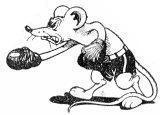
|
GIVES FIVE M.P.'S ROUGH TUSSLE
ALONG THE LEDO ROAD - A bunch of the boys - five tall, burly M.P.'s - were sitting around in one of those Burma day rooms, when their haven of rest was suddenly invaded by one each rat, large, belligerent.
They promptly started to work him over, M.P. style, with all available equipment. But the rat, far from fazed, kept running up the wall and leaping in their faces. His attackers spent half their time swinging and half scrambling to scram out of the joint. Wreckage everywhere, a hell of a mess.
Finally, Pfc. John Modderelli scored with a sofa cushion to the head. The Pvt. Pete Uzzo connected with a bench to the rat's whiskers. Cpl. Jerry Trimaico followed with a swift iron stool to the midriff, and Pvts. Walter Fatz and Cliff Taft administered the coup de grace to the now dejected rodent.
Moral: Things need never be dull if you'll only show a little initiative in thinking up amusement.
A PROBLEM SOLVED
ATC BASE, ASSAM - Innerspring mattresses aren't normally found on bunks of G.I.'s stationed in the wilds of Assam, but QM here went all out to prepare a similar seducer-to-slumber for Pvt. James Mason, who works in the motor pool. It wasn't Mason's plight which touched QM, because its heart is just as tough as those of other QM departments. It was the plight of the G.I. cots that turned the trick. Mason weighs 332 pounds and three G.I. cots, in rapid succession, succumbed under the crushing weight as the big hunk of man tried vainly to relax. Their fate brought a cry of anguish from the lips of the bewildered QM. For a few nights thereafter, Mason was forced to recline, somewhat uncomfortably, on the floor until the C.O., the Service and Supply Officer and the Welding Department joined the QM boys in a huddle. They came up with a reinforced, hand-made "charpoy" manufactured from two-inch water pipe, welded together, with bands of rubber cut from discarded airplane inner tubes stretched across as springs. Now Mason relaxes in comfort, and each night as he sinks peacefully, if a bit noisily, into the arms of Morpheus, he offers thanksgiving blessings to his benefactors. |
G.I. PAINTS MURAL
ATC BASE, INDIA - Finishing touches on a chancel mural has marked completion of a chapel here. From a bare, empty basha, personnel at this India-China Division ATC base has whittled, hacked, hammered and painted the chapel, replete with mahogany altar and chancel mural. Sgt. Jay H. Bronson, of Wesleyville, Pa., spent a month of his spare time working on the mural, which consists of three Gothic windows, the center one containing a larger than life-size likeness of Christ. Bronson purchased all supplies used in the work of art in various parts of India, while on furlough. The painting, four by eight feet in size, was copied from a picture two and one-half by five inches in Bronson's prayer book. The mural was accomplished without the use of blacks. The darker shades were obtained by blending reds and blues. The artist, who works in the Communications section, dedicated the painting to his mother. The chapel seats 200 and also accommodates a choir of eight in the chancel. The 65 by 36 foot bamboo basha also houses the office of Chaplain Robert G. Patterson. Lack of supplies hampered activities of the chapel at first, but the staff got around the hymnal shortage by mimeographing copies of hymns used in services. Sgt Clarence W. King is chaplain's assistant, Sgt. Robert G. Campbell, of Bloomfield Hills, Mich., is pianist and choir director. |
P-38 TWIN DRAGONS GET COMMENDATION
The "Twin Dragons" P-38 squadron of the Third Tactical Air Force, Eastern Air Command, has been cited by Lt. Gen. Dan I. Sultan, Commanding General of U.S. Forces in India-Burma, for "outstanding performance of duty in action" between March 11 and May 19 of this year. It was announced this week.
Says the citation, "During this period the squadron conducted a series of fighter sweeps, escort, bombing and strafing missions deep into the enemy's territory. Through lack of aircraft and spares, the squadron was operating at approximately one-half strength. Although forced to continually seek out and attack the enemy over his own airdromes, the squadron succeeded in destroying 119 enemy aircraft during these 70 days . . . with a loss of only seven of their own aircraft. This achievement reflects highest credit upon the military forces of the Allied Nations."
10 Nip Aircraft Brought Down By AA Battery
MYITKYINA - Hidden under a blanket of censorship, security and modesty for some 29 months in the jungles of Assam and Burma, the praiseworthy conduct of an anti-aircraft machine gun battery was brought to light this week.
An account of the outfit's deeds reveal that 10 Jap planes have been destroyed by the battery's keen marksmanship, in addition to four probables and two damaged.
SHARP FROM START
Now busy keeping the skies over Northern Burma clear of enemy planes, this first anti-aircraft machine gun battery to arrive in the Far East, began its combat career in Assam, where during two attacks by Jap aircraft, it knocked down five Nip planes, plus two probables.
It was while in Assam that the outfit incurred its first casualty, an officer killed by bomb fragments. For "bravery in action" in this fracas, two men were awarded the Silver Star.
MOVE TO MYITKYINA
Then came a move to Myitkyina. On D-Day, the outfit landed alongside the first airborne troops, set up its guns in the face of heavy ground opposition and added two more enemy planes to its scoreboard. In the weeks following the invasion, they knocked out three more Jap ships.
For their important part in the Myitkyina campaign the outfit has been given a special commendation by the 10th Air Force.
HOBBIE LEARNS ABOUT SANTA
|
BURMA - "Astute" is now the word that describes Hobbie Tezpur, four-year-old mascot of the Burma Peacocks Air Service Group in the Myitkyina area. Up to now little Hobbie, who was found in an Assamese jungle near Tezpur where he hid out as an orphan of the war migration, was known for his smiles, laughs and general good nature. And his exemplary conduct had won him steady honorary promotion to his most recent rank of "sergeant."
Last week, Hobbie got to wondering why everybody was talking about "Christmas."
"What's Christmas? he asked Col. William S. Pocock, Jr., the Burma Peacock's commanding officer.
"Why, Hobbie, don't you know what Christmas is? You haven't heard of Santa Claus?"
"No, colonel. Who is Santa Claus?"
The C.O. decided that Hobbie's official guardian, M/Sgt. Carton T. (C.T.) Williamson, should hold an orientation lesson, so he sent Hobbie to C.T.
"Hey, C.T.," asked the mascot, "who is Santa Claus?"
"Why Santa Claus is a nice old man with a long white beard."
Hobbie reflected silently and said, "I thought that was Uncle Sam."
|
APO 487 (Dinjan, India) - When Cpl. Jack F. Hart came overseas five months ago for the second time in two years, he ran smack dab into his brother-in-law, T/Sgt. Horace Hicks, who generously awarded his relative with an appropriate welcome-to-Burma gift - one each, tent, tropical, fully furnished. Hart, who spent considerable time with the Air Force during the North Africa and Sicily campaigns, knew all along that his brother-in-law was "somewhere in CBI" with the Signal Corps, but it was luck, fate and the Army redistribution center that finally brought the two together in Burma. Their reunion was short-lived, however, for Hicks was soon moved to another base, leaving Hart behind, comfortably ensconced in his new tent. |
|
ASC BASE, BURMA - Realizing that "it's only human nature" for a man to jump into the nearest foxhole when an air raid alarm is sounded, members of the Burma Peacocks here at Myitkyina airstrip are now posting various "no trespassing" signs above their underground bedrooms. After living conditions in these small hideouts became too crowded occasionally with non-paying (i.e. non-digging) guests, the signs, reading "Private. Keep Out." and identifying the rightful owners, began popping up all over the vicinity. The action was also prompted by a 230-pound major, who plopped his tonnage into a foxhole one recent night and made a "human sandwich" of two earlier arrivals. |

Landed Her Safely |
20TH BOMBER COMMAND BASE, INDIA - When the huge B-29 Super-Forts run out of gas in flight, you fly 'em home on pure guts, plus a keen knowledge of the flying machine and its delicate operation.
At least that's the recipe Capt. Charles (Doc) Joyce and his flight engineer, Charles Passieu, used recently while bringing in their Super-Fortress Raidin' Maiden, after giving Singapore its first aerial bombardment of the war.
Joyce and his crew had just put the finishing touches on the successful bombing of Singapore and were nearing their home base, when Passieu announced to his pilot that the gas supply was running alarmingly low. So low, in fact that he doubted very much whether Raidin' Maiden could make the next 70 miles to its base.
Hearing this, the pilot, short in stature but long on intestinal fortitude, gave the only order he could: "Bail out." After this emergency bell had been sounded throughout the big ship, Joyce decided to stay with her, because he "kinda figured we might be able to make it." Passieu shared this opinion and stayed with his pilot.
About 10 miles from home, Joyce inquired: "How much gas left, Charlie?"
"Just about enough to fill your cigarette lighter," came the answer.
Almost within sight of base, Joyce realized his predicament and acted accordingly. At 10,000 feet, he cut the switch, feathered the props, nosed the giant plane into a steep dive, lowered the landing gear - and then began praying he might thus maintain enough air speed for a safe landing.
Raidin' Maiden touched ground just 40 feet short of the runway, but Joyce wrestled the plane onto the airstrip and rolled safely past an amazed and cheering crowd gathered around the control tower.
An anti-climax to the story occurred when Joyce and Passieu stepped out of the plane - so did five other crew members. They had been in the rear of the ship and had not heard the "bail out" alarm. When they realized what had happened, it was too late to jump. That's their story. The other four crewmen who were in the front of the ship, bailed out at the pilot's command and landed safely several miles from the field.
Joyce's modest comment as he mopped up the perspiration from his smiling face: "We were just lucky as hell, I guess."
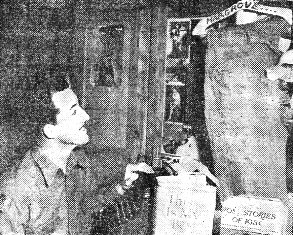
You, too, Can Become a Successful Author. |
HIS FORMULA WEIRD, BUT IT WORKED
14TH AIR FORCE HQ. - You, too, can become a successful short-story author.
You don't have to marry the editor's daughter, either. Here's the magic formula, according to S/Sgt. John Geoghegan, who has a check for a story from the slick and highbrow Story magazine:
You merely join the Air Corps, finagle yourself into Maj. Gen. C. L. Chennault's 14th Air Force "Flying Tigers," and seek out the room where Sgt. Marion Hargrove, who hit the literary jackpot with See Here, Private Hargrove, once made his abode.
After making yourself comfortable for awhile on the sack where Hargrove used to lay his humorous frame, you just dream and think of yourself as another Hemingway, Hargrove or whoever collects the cabbage for merely beating a typewriter to a frazzle.
As a neat, orderly soldier, you will want to hang your misfits on a clothes hanger. The hangers, Geoghegan claims, really furnish the magic touch. See Here, Private Hargrove saw to it that the hangers he left behind were firmly inscribed with the word Hargrove.
And that, you envious hackwriters, is how Geoghegan became another star in the literary firmament. Oh, yes, one minor item: You have to write the story.
Geoghegan's story, a tale of the tragedy of life and death during a Jap air raid, Ching Pao, is his first to be accepted for publication. Here, again, Geoghegan's Irish luck followed him, because Whit Burnet, editor of Story is also the fellow who discovered these now famous writers: William Saroyan, Jesse Stuart and Mary McCarthy of My Friend Flicka fame.
The literary sergeant, 27, has been writing since 19, and is naturally happy about hitting the big time. In civilian life, he lived in Germantown, Pa., and his urge for writing was so strong that he commuted once a week, between a sales job, to take a short-story course at Columbia University, New York City.
Along with the check, the editor of Story has asked to see a novel. New author Geoghegan is more than slightly worried. If he could only find an old castoff pair of Hargrove's fatigues he'd be ready to write it.
TELEPHONE TALE
ALONG THE LEDO ROAD - A telephone switchboard operator here tells of an incident that is not without some comedy. A call came for the officers' quarters. No one answered. So the operator "gave 'er a long 'un." Much to his surprise, an angry voice came over the wire, in that ungentle tone angry, disturbed people use, "There's nobody here, why don't you shut up?"
MEDIC IN BURMA MAKER OF MUSIC
BURMA - During duty hours, Pfc. Lawrence P. Brown capably tends to the medical needs of his comrades, but in his spare time he literally "makes music."
brown, member of a Medical detachment here, spends most of his off-duty hours making stringed musical instruments out of whatever materials available. He admits that guitars are his specialty, but he also has thrown together some right snappy ukuleles and mandolins.
Vignette
CHINESE DISPLAY YANK INGENUITY
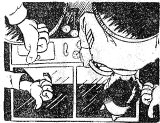
|
ALONG THE LEDO ROAD - The Chinese seem to have learned well the game of "hitchhiking." There is something American about this little incident.
The other day, a jeep came hopping along the Ledo Road and as it neared a traffic control station the driver noticed a solitary Chinese soldier "thumbing" in the same direction he was going. He stopped to give him a ride. As the jeep ground to a stop, the Chinese G.I. let out a yell in the direction of the nearby building and out poured six or eight non-descript human beings with scanty "baggage."
The Chinese no doubt had great confidence in the ability of a little jeep, but the driver gave one look at that crowd and yelled a no-so-polite "boo how" and started off in white heat.
BOMB UNIT CLAIMS 'YOUNGEST PILOT'
BURMA - "Out of the cradle and into the pilot's seat of a B-25" is quite a leap in anybody's league, but that's the statement of the Black Angel Squadron of the Earthquaker Group in their contention that F/O David Croom at the age of 20 is "the youngest pilot" in this neck of the war.
"Junior" Croom, who now has 37 combat missions to his credit, didn't actually trade his swaddling clothes for a pilot's khaki uniform, but he did speed up the transformation a bit.
Born in 1924 back in Marshall, Tex., he grabbed his high school diploma in 1942 and almost immediately joined the Army, winning his wings at Turner Field, Ga., a few months later.
The "youngest pilot" hit North Africa in 1944, and a few weeks later was assigned to the Earthquaker Bomb Group in Italy and is now with the outfit in Burma, where the Japs, no doubt, will tell you, "He fights just like a grown man."

|
BAG 450-POUND TIGER
NORTH BURMA - Two sharp-shooting G.I.'s of an Engineering unit recently killed a 450-pound Bengal tiger measuring over eight feet long, scoring five hits in eight shots with their service rifles to stop the big cat in its attempted flight.
T/5's Winslo Ash and Gerald Huth were beating their way through heavy elephant grass towards a Burmese temple, located atop a small hill and surrounded on three sides by a lake, when they broke through an abandoned bamboo-covered Jap foxhole. The noise evidently roused the tiger, who had been sleeping in the shade of the temple, about 50 feet away, and the beast, with an angry growl, dashed into the heavy undergrowth to escape.
THIRD SHOT A STRIKE
The boys, accompanied by T/5's Julius Mertz and Joe Brown, hurried to the high ground beside the temple, from where they spotted the tiger proceeding across a rice paddy and not far off. Ash opened fire and downed the cat with his third shot. Huth than joined in, scored a hit, and the two marksmen pinned the quarry to the ground with four more quick shots. Mertz and Brown cautiously approached the animal, their rifles ready, but he was quite dead.
Using gunfire to cut down poles, the huntsmen now attempted to sling the tiger and haul him back to camp, but found his weight too much for them.
USED A TRACTOR
They returned to camp for a tractor and trailer, to be greeted with skeptical murmurs of "jungle Happy" at their odd request. Skeptics were convinced, however, when the four brought the trophy in soon afterwards, and their buddies fell out in a body to view and shoot numerous pictures of the prize.
Later, when the tiger was skinned, five wounds were found, one tracer bullet hitting below the heart probably having proved fatal. The beast measured 39½ inches from ground to shoulder and his forepaws had a 12-inch spread, making a six-inch track.
KACHINS GO HOME ON LEAVE AFTER TWO YEARS
MYITKYINA - (UP) - All the Kachin nats are comfortably seated on their sharpened bamboo stakes, most of Burma's contingent of Kachin Levies have gone home on leave and all's right with the Kachin world in Burma today.
Nats, according to people who say they know, are Kachin gods. More correctly, they're Kachin devils. At any rate, they're evil characters and the Kachin religion, informed sources say, is based on appeasing the nats so disaster won't fall about the heads of the Kachins, their crops, and, particularly at the present, their war against the Japanese.
The Kachins have dealt the Japanese untold misery. They can be perhaps compared with the American Indian in their methods of fighting and their knowledge of nature and the jungles. They fight a war of ambush, and on one occasion killed 120 of 200 ambushed Japanese. At least, 120 bodies were all that were found.
Now most of the Levies have gone home for their first leave in two years. But before they went, they staged a ceremony celebrating their departure and appealing to the nats to be good characters and leave well enough alone.
NATS TAKE A SEAT
According to the informed sources, the Kachins place sharpened bamboo stakes in the ground as resting places for the nats. They believe the nats sit on the stakes. A thousand or more can sit on one stake at the same time, which probably accounts for the respect they receive.
The main purpose of this recent festival and ceremony was to keep the nats on the stakes and away from dabbling in the affairs of men.
The celebration included tribal dances to the monotonous rhythym of gongs and small leather drums, drinking of rice beer, rice wine and 140 proof distilled bamboo juice, and the sacrifices of cows. The cows were sacrificed by stabbing them to death with sharpened bamboo spears.
The ceremony began in a large circular enclosure about 100 feet in diameter, fenced in by a low, woven bamboo fence. In the center were several symbols of a religious nature, about a foot wide and 12 feet tall, covered with parachute cloth on which were painted intricate but not inartistic designs, each having its own special meaning.
'RHUMBA' DANCE
A British officer who keeps up with such things said that a tall symbol in the center represented the religious head man. On each side were his assistants and beyond each of them was a symbol representing the assistance wife. Before the officer could point out the location of the head man's wife, the ceremony began with a shrill blast from a policeman's whistle and a bang on a gong.
The dances, one by each of the seven tribes represented in the Kachin Levies, were simple rhythmic affairs, with the participants hopping or stepping or waving their arms in time with the slow gong beat. One such, with the dancers forming a long line, looked like and early morning rhumba line made up of people too tired to go home. Another, a circular jumping business accompanied by yells and gestures, was something like American Indian war dances. Most exciting was a solo dance by a man armed with two long, razor-sharp knives, which he brandished about his head, seemingly making passes at his own throat. He completed his routine unscathed.
After the dances came the speeches, which everyone cheered, and then the sacrifices. Then the meat was carted away, part to be distributed about in the jungle for the sake of the nats, and the rest to be cooked for eating.
Then, the serious drinking, after which the party broke up like gay parties everywhere else - the participants went home to their wives.
SIX AIRMEN GIVEN AWARDS IN ASSAM
ASSAM AIR BASE - Six airmen, for meritorious service in flying The Hump, were awarded decorations here recently, presentation being made by Maj. Charles W. Gatschet, base commander.
For participating in more than 600 hours of operational flight, Lt. Gerald B. Brewster and Cpl. Harry L. Weeks were awarded the Distinguished Flying Cross with Oak Leaf Cluster.
Air Medals were presented to one officer and three enlisted men for successful completion of more than 150 hours of flight over the same route. Recipients were Cpl. Howard E. Faison, Sgt. Arthur Weinstein, S/Sgt. Thomas J. Higgins, and Lt. Jack P. Coy.
ATC BRANCHES INTO CIVILIAN FIELD
In line with recent innovations, such as a flight clerk to serve hot coffee to generals and privates alike, plus a ramp for potential rheumatic descenders, India-China Wing of Air Transport Command has now branched into the civilian field.
Any civilian, on business directly connected with the war effort, can disburse the asked amount of rupees, buy a ticket to his destination and hop off on an ATC plane.
First civilian to take advantage of this offer was N. J. Stork, director of General Motors Technical Center in India. Stork, an old but unwilling patron of the panting Indian Railway System, purchased a ducat for Calcutta, where he had an urgent conference with company officials scheduled.
 Pat O'Brien gets ready to hit one on the nose in a softball game at 14th AF HQ. O'Brien proved himself an
athlete as well as an actor to the delight of a large G.I. crowd in a game which O'Brien pitched against Maj. Gen.
Claire L. Chennault.
Pat O'Brien gets ready to hit one on the nose in a softball game at 14th AF HQ. O'Brien proved himself an
athlete as well as an actor to the delight of a large G.I. crowd in a game which O'Brien pitched against Maj. Gen.
Claire L. Chennault.
|
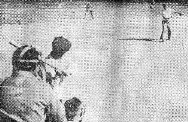 The pitcher at the far right is two-star Chennault, who gets his rare moments of relaxation by playing softball
with the G.I.'s. At bat is Pat O'Brien who was his mound opponent. The catcher is Brig. Gen. Edgar Glenn,
Chief of Staff of the 14th.
The pitcher at the far right is two-star Chennault, who gets his rare moments of relaxation by playing softball
with the G.I.'s. At bat is Pat O'Brien who was his mound opponent. The catcher is Brig. Gen. Edgar Glenn,
Chief of Staff of the 14th.
|
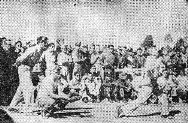 At the bat is Brig. Gen. Glenn, who swings a mean stick from the southpaw side of the plate. If this plate
has been reversed and the general bats righthanded we present our apologies beforehand. No score was sent in so
we assume the generals lost.
At the bat is Brig. Gen. Glenn, who swings a mean stick from the southpaw side of the plate. If this plate
has been reversed and the general bats righthanded we present our apologies beforehand. No score was sent in so
we assume the generals lost.
|
GUNGA DIN HAS HAD IT
NEW DELHI - Gunga Din, immortalized by Rudyard Kipling as the prototype of Indian Army water-carriers, has been honorably retired after generations of faithful service.
Water-carriers are no longer authorized for active units and the order has gone forth that all water-carriers now serving in such units will be given the option of transfer to combatant status.
Those willing to become combatants will be re-enlisted and, if found medically fit, be given additional training in general soldiering. Orders for the disposal of the remainder will be issued by regimental centers and depots.
"The carrying of water," says an Army instruction, "will thus cease to be a task to be carried out by non-combatants but will be the normal duty of any soldier detailed at the time."
The C.B.I. Roundup is a weekly newspaper of the United States Forces, published by and for the men in China, Burma, and India, from news and pictures supplied by staff members, soldier correspondents, United Press, OWI, and Army News Service. The Roundup is published Thursday of each week and is printed by The Statesman in New Delhi and Calcutta, India. Editorial matter should be sent directly to Capt. Floyd Walter, Hq., U.S.F., I.B.T., New Delhi, India, and should arrive not later than Sunday in order to be included in that week's issue. Pictures must arrive by Saturday and must be negatives or enlargements. Stories should contain full name and organization of sender. Complaints about circulation should be sent directly to Lt. Boyd Sinclair, Hq., U.S.F., I.B.T., New Delhi, India. Units on the mailing list should make notification of any major change in personnel strength or any change of APO.

NOVEMBER 23, 1944
Original issue of C.B.I. Roundup shared by CBI veteran Robert L. Shaw
Copyright © 2006 Carl Warren Weidenburner
TOP OF PAGE PRINT THIS PAGE ABOUT THIS PAGE SEND COMMENTS
PREVIOUS ISSUE CLOSE THIS WINDOW NEXT ISSUE


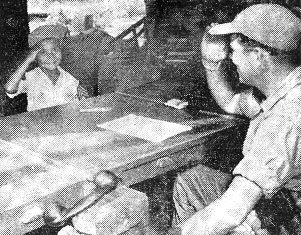 Hobbie Tezpur, four-year-old mascot of the Burma Peacocks, reports to Capt. Charles A. Herzog, Group Engineering
Officer, on his first day as an honorary sergeant.
Hobbie Tezpur, four-year-old mascot of the Burma Peacocks, reports to Capt. Charles A. Herzog, Group Engineering
Officer, on his first day as an honorary sergeant.